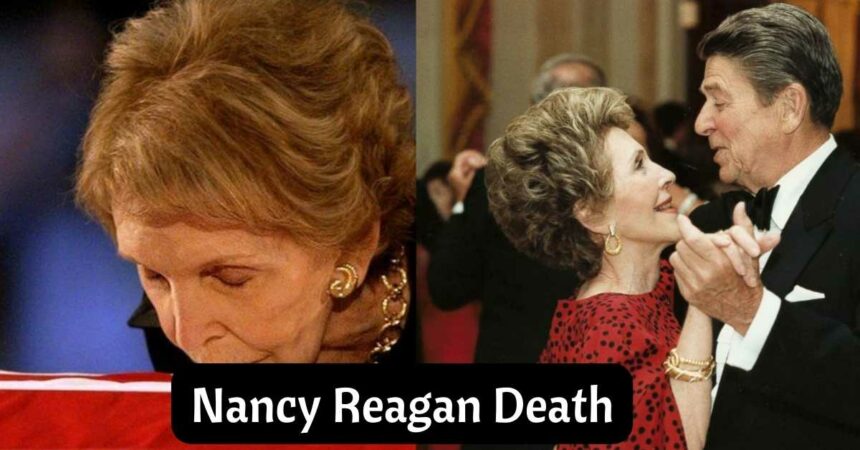Nancy Reagan, whose life spanned from July 6, 1921, to March 6, 2016, lived a remarkable and varied life. Born as Anne Frances “Nancy” Robbins in the bustling city of New York, her parents’ separation marked her early years.
Following their split, Nancy spent six years living with her aunt and uncle in Maryland while her mother, pursuing an acting career, was unable to care for her. In 1929, Nancy’s mother, Edith Luckett, married Loyal Edward Davis, a prominent neurosurgeon from Chicago.
This union brought mother and daughter back together in Chicago, where Nancy attended school, transitioning into her teenage years. It was during this time that Dr. Davis, whom Nancy came to regard as her father, formally adopted her, leading to her becoming Nancy Davis from Anne Frances Robbins.
Nancy Reagan Career
Completing her education, Nancy graduated from Smith College in 1943 and embarked on a career in acting. She graced the stage, film, and television screens, eventually signing a contract with MGM in 1949. Throughout her acting journey, she starred in several films, including her last one, “Hellcats of the Navy,” in 1956, where she shared the screen with her husband, actor Ronald Reagan.
Explore other related posts listed below in the death:
- Eliza Fletcher Cause Of Death: Autopsy Report Reveals Sparks Shock And Grief!!
- Marcus Gunn Death: David Gunn’s Nephew Passes Away At 25!!
The course of Nancy’s life shifted when, in a twist of fate, she and Ronald Reagan were introduced during a dinner date to address a mix-up involving another actress with the same name. Love blossomed between them, leading to their marriage on March 4, 1952. It was Nancy’s first marriage and Ronald’s second; he had previously been wed to actress Jane Wyman.
Ronald Reagan’s political journey took them to the Governor’s mansion in California in 1967, marking Nancy as the First Lady of California. During this time, she commenced her charitable endeavors, commencing with visits to wounded Vietnam War veterans, elderly care facilities, and schools for children with special needs.
Her dedication extended to initiatives concerning prisoners of war (POWs) and missing service members. Nancy also became a syndicated columnist, directing her earnings to support the National League of Families of American Prisoners and Missing in Action in Southeast Asia.
Her connection with older people prompted her to champion the Foster Grandparent Program in 1967. This program brought senior citizens and disabled children together, and Nancy emerged as its staunch advocate. As she assumed the role of First Lady of the United States when Ronald Reagan became President in 1981, she expanded her philanthropic efforts to combat drug and alcohol abuse among youth.
Nancy traveled extensively, covering nearly 250,000 miles throughout the United States and beyond, in her campaign to combat substance abuse. She appeared on television shows, recorded public service announcements, authored articles, and visited prevention and rehabilitation programs nationwide.
Nancy Reagan Death
In 1985, she took her mission international by hosting a global briefing for First Ladies on youth drug misuse and a drug conference during the 40th Anniversary of The United Nations. Beyond her philanthropic work, Nancy was known for her love of entertaining, home decoration, and fashion.
Her sophisticated style garnered attention, especially given the economic challenges facing the nation during the early years of the Reagan Administration. However, Nancy’s image softened when she revealed that designers had lent her clothing. This was humorously reinforced when she appeared at the annual Gridiron Dinner in Washington, DC, playfully embracing her image in a mismatched wardrobe performance of “Second Hand Rose,” delighting both the press and the public.
Despite the controversies, Nancy Reagan had her share of admirers. Annual Gallup Polls from 1981 to 1989 consistently ranked her as one of the ten most admired women globally, with several top-ranking years.
In October 1987, a mammogram revealed breast cancer, leading to her undergoing a radical mastectomy. Nancy chose to share her diagnosis and treatment with the public, becoming an advocate for early detection.
Following her time in the White House, Nancy Reagan continued her crusade against substance abuse by founding the Nancy Reagan Foundation. She collaborated with the BEST Foundation For A Drug-Free Tomorrow to develop the Nancy Reagan Afterschool Program in 1994.
Nancy traveled extensively, domestically and internationally, raising awareness about the harmful effects of drugs and alcohol. In 1989, she penned her memoir, “My Turn,” and remained active in projects related to the Ronald Reagan Presidential Library.
She served on the Board of the Ronald Reagan Presidential Foundation, dedicated to preserving President Reagan’s core beliefs, and published “I Love You, Ronnie: The Letters of Ronald Reagan to Nancy Reagan” in 2000.
Nancy Reagan’s Caus of Death
Her later years were primarily dedicated to caring for her husband, President Ronald Reagan, who battled Alzheimer’s Disease. Their courageous and candid journey through his decline and eventual passing deeply resonated with the world.
After President Reagan’s death, Nancy Reagan continued her advocacy work, collaborating with the National Alzheimer’s Association and the Ronald & Nancy Reagan Research Institute. She also became a vocal proponent of stem cell research as a potential treatment for Alzheimer’s Disease, influencing federal funding decisions.
In order to uphold President Reagan’s legacy, Nancy Reagan accepted honors on his behalf and collaborated with the Ronald Reagan Presidential Foundation to mark his 100th birthday in 2011.
Her health deteriorated as a result of numerous falls at home that left her with damaged bones. At the age of 94, she passed away at her home in Bel Air, California, on March 6, 2016. On the grounds of the Ronald Reagan Presidential Library, Nancy Reagan was buried next to her devoted husband, President Reagan.




